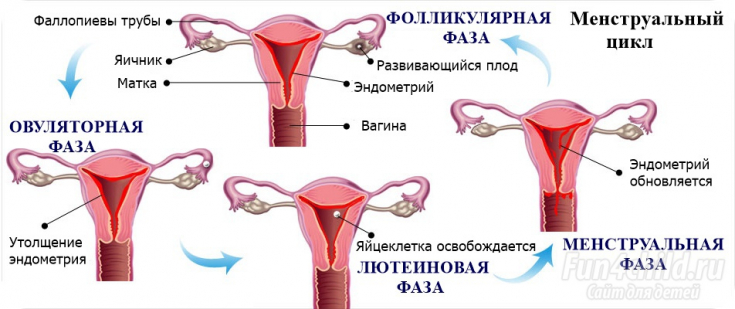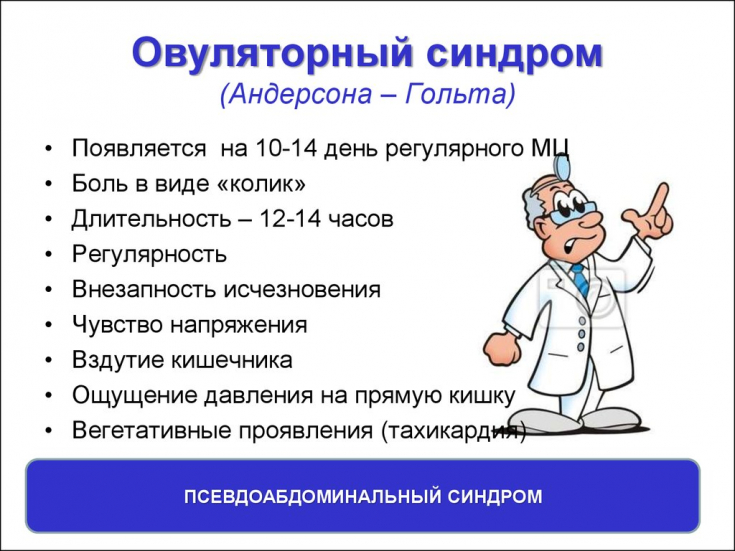Many women suffering from feeling bad in the middle of their menstrual cycle don know that it — ovulatory syndrome.
According to various estimates, painful ovulation is observed in 40-65% of women of childbearing age, which makes this condition the most common cause of a decrease in the quality of life in these "cherished" days of the menstrual period.
But can can handle pain and how?
- Painful ovulation: causes of ovulatory syndrome
- Painful ovulation: associated signs of ovulatory syndrome
- Methods and remedies for the treatment of painful ovulation
Painful ovulation: causes of ovulatory syndrome
Unfortunately, women health experts still cannot explain exactly what causes pain and other unpleasant symptoms during ovulation.
The most likely is the theory of rupture of the walls of the follicle — in a kind of capsule in which the egg matures. At the moment of rupture of the wall, the egg leaves the follicle, and blood is released from the damaged area, which enters the abdominal cavity and irritates it.

But the question remains why not all women suffer from ovulatory syndrome, if everyone has follicle rupture.
Today, hypotheses are being explored that ovulation pain is due to a denser follicle wall and its more active blood supply in some women. And that those who suffer from ovulatory syndrome have increased sensitivity of the nerve endings that "translate" pain signal.
But these versions have yet to be confirmed or denied.
Read also: Hormonal cycles: the best recommendations for women
Painful ovulation: concomitant signs of ovulatory syndrome
In itself, the term "syndrome" means a whole set of symptoms. With ovulatory syndrome, women most often complain of such manifestations of this condition:
-
Pain in stomach.It is described as dull and aching, sharp and paroxysmal, covering the entire lower abdomen or present only on the left or right (depending on in which ovary, the maturation of the egg occurred in this cycle). Some women experience referred pain that is felt most strongly in the lower back and is aching in nature. The pain usually lasts 10-15 hours and passes on its own.
-
Bleeding. They appear on the same day as pain, or after 1-2 days after the onset of pain. By color and consistency, they may resemble discharge at the very beginning of menstruation — dark and pasty or bright red and slimy, it depends on how much time elapsed between the rupture of the follicle and how the blood "got" until exit. The longer the time interval, the more oxidized and darkens the blood. Discharges are usually few, not more 1-2 ml.
-
False urge to defaecate. About a quarter of women suffering from ovulatory syndrome complain of a feeling of pressure in the rectum, which is reminiscent of the urge to toilet. It is believed that this is due to irritation of the nerve receptors by the blood that was released during the rupture of the follicle.

The listed symptoms may occur in various combinations, and not all are necessarily present. But in in all cases women experience pain and naturally look for ways to get rid of
Read also: Contraceptive pills after 40 years: pros and cons of drugs
Methods and remedies for the treatment of painful ovulation
First of all, you need to know: the symptoms of ovulatory syndrome are considered conditionally normal and refer to individual reactions of the body if they:
-
Observed on the the same days of each cycle
-
Does strengthen
-
The they are not joined by other symptoms of possible distress
-
The the rest of the days of your menstrual cycle, you feel normal
Among the methods and remedies recommended by gynecologists for the treatment of painful ovulation, the following are most effective:
- NSAIDs.
This group of medicines helps to eliminate pain, but a specific drug should be selected by a doctor, taking into account indications and contraindications.
- Using oral contraceptives.
In some cases, if the doctor has reason to assume hormonal as the cause of ovulatory syndrome, he can recommend oral contraceptives, which in this case play the role of hormone replacement therapy and correct the hormonal balance.
Follow us on Telegram But it is considered most useful to adjust your lifestyle 2-3 days before expected ovulation. Eliminate physical activity, give preference not to a hot bath, but to a warm shower, refuse to wear tight jeans, and do not allow hypothermia. These simple measures will help to significantly reduce the discomfort during ovulation.
Read also:Signs of ovulation every woman should know
You might be interested in: Abs Workouts.








Add a comment